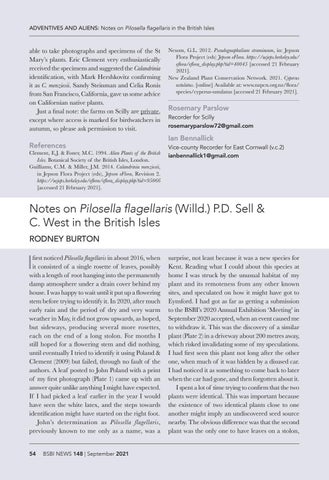ADVENTIVES AND ALIENS: Notes on Pilosella flagellaris in the British Isles
able to take photographs and specimens of the St Mary’s plants. Eric Clement very enthusiastically received the specimens and suggested the Calandrinia identification, with Mark Hershkovitz confirming it as C. menziesii. Sandy Steinman and Celia Ronis from San Francisco, California, gave us some advice on Californian native plants. Just a final note: the farms on Scilly are private, except where access is marked for birdwatchers in autumn, so please ask permission to visit.
References
Clement, E.J. & Foster, M.C. 1994. Alien Plants of the British Isles. Botanical Society of the British Isles, London. Guilliams, C.M. & Miller, J.M. 2014. Calandrinia menziesii, in Jepson Flora Project (eds), Jepson eFlora, Revision 2. https://ucjeps.berkeley.edu/eflora/eflora_display.php?tid=95066 [accessed 21 February 2021].
Nesom, G.L. 2012. Pseudognaphalium stramineum, in: Jepson Flora Project (eds) Jepson eFlora. https://ucjeps.berkeley.edu/ eflora/eflora_display.php?tid=40045 [accessed 21 February 2021]. New Zealand Plant Conservation Network. 2021. Cyperus ustulatus. [online] Available at: www.nzpcn.org.nz/flora/ species/cyperus-ustulatus [accessed 21 February 2021].
Rosemary Parslow
Recorder for Scilly rosemaryparslow72@gmail.com
Ian Bennallick
Vice-county Recorder for East Cornwall (v.c.2) ianbennallick1@gmail.com
Notes on Pilosella flagellaris (Willd.) P.D. Sell & C. West in the British Isles RODNEY BURTON
I
first noticed Pilosella flagellaris in about 2016, when it consisted of a single rosette of leaves, possibly with a length of root hanging into the permanently damp atmosphere under a drain cover behind my house. I was happy to wait until it put up a flowering stem before trying to identify it. In 2020, after much early rain and the period of dry and very warm weather in May, it did not grow upwards, as hoped, but sideways, producing several more rosettes, each on the end of a long stolon. For months I still hoped for a flowering stem and did nothing, until eventually I tried to identify it using Poland & Clement (2009) but failed, through no fault of the authors. A leaf posted to John Poland with a print of my first photograph (Plate 1) came up with an answer quite unlike anything I might have expected. If I had picked a leaf earlier in the year I would have seen the white latex, and the steps towards identification might have started on the right foot. John’s determination as Pilosella flagellaris, previously known to me only as a name, was a 54
BSBI NEWS 148 | September 2021
surprise, not least because it was a new species for Kent. Reading what I could about this species at home I was struck by the unusual habitat of my plant and its remoteness from any other known sites, and speculated on how it might have got to Eynsford. I had got as far as getting a submission to the BSBI’s 2020 Annual Exhibition ‘Meeting’ in September 2020 accepted, when an event caused me to withdraw it. This was the discovery of a similar plant (Plate 2) in a driveway about 200 metres away, which risked invalidating some of my speculations. I had first seen this plant not long after the other one, when much of it was hidden by a disused car. I had noticed it as something to come back to later when the car had gone, and then forgotten about it. I spent a lot of time trying to confirm that the two plants were identical. This was important because the existence of two identical plants close to one another might imply an undiscovered seed source nearby. The obvious difference was that the second plant was the only one to have leaves on a stolon,

















